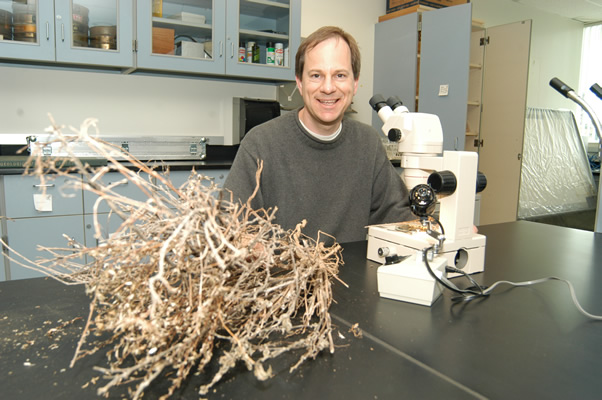How Dry We'll Be
Native Shrubs Can and Need to Survive Ever-Drier Climate
February 3, 2009
By Russ L. Hudson
A Cal State Fullerton biologist used the eyes of an engineer to study how dry-area shrubs can sustain considerable damage and survive while some wet-area shrubs succumb to little damage, such as drought. The findings have implications for water conservation, wildfires and soil erosion.
“I started with the assumption that shrubs must have evolved with principles familiar to hydraulic engineers,” said Jochen Schenk, associate professor of biological science. “They must have resistance to hydraulic failure, must be self-repairing and must have redundant systems.”
Based on those principles, “Dry-area shrubs take the advantage. Wet-area shrubs have constant water, so they have evolved few pathways to transport it, leaving little backup for recovery,” said Schenk. “To compensate for scarce water, dry-area shrubs have evolved many pathways clumped together, like a handful of straws held by a rubber band. When one pathway is blocked or damaged beyond repair, only that part of the shrub dies. Chances are good other parts will make it through.”
In addition, Schenk added, shrubs in the Southwest have evolved to recover quickly after fires, further enhancing survivability.
In a paper recently published in the Proceedings of the National Academy of Sciences, Schenk and collaborators reported that the different levels of redundancy between wet-area and dry-area shrubs are clearly reflected in their growth forms. “Take a look at native shrubs on your next hike in our local mountains or desert,” Schenk said.
“For the most part, you won’t find many species with round trunks at their base, just separate branches sticking out from the ground. These branches each have their separate hydraulic system. Compare that to your average landscaping shrubs and you will find mostly round trunks and stems,” said Schenk.
Desert shrubs, such as the creosote bush, divide into separate parts and can survive for hundreds or even thousands of years. It seems likely they will be able to survive a hotter and drier climate, Schenk said. Round-stemmed shrubs and trees from wetter areas that have been planted all over Southern California won’t be so lucky, especially as water becomes scarce for irrigation.
“Having only one hydraulic system, they have only one ticket in the lottery of life. If predictions are accurate that our climate will get hotter and drier, then the native plants that have more hydraulic systems will have better chances,” said Schenk.
Studies show that global warming and post-ice age climate trends have combined to make the Southwest progressively hotter and drier. Among other implications, Schenck's findings suggest adaptations in land-use planning. Where native dry-land shrubs have been replaced by “prettier” landscaping shrubs — a trend in some areas of the Southwest — lack of rain and available irrigation water could spawn 1930s-style dust storms, according to computer models reported by the Intergovernmental Panel on Climate Change.
Since a hotter, drier climate means less water to put on water-hungry landscaping plants, dry-land shrubs will start to predominate in landscaping, as well as on untouched land, an increasingly important factor for land planners to consider, firefighters say.
Dry-area plants need to be preserved in order to hold soil and eco-systems in place, said Schenk, although these same plants, when dry at the end of summer, are more flammable than well-watered plants from wet areas. So should native shrubs be preserved?
“Yes,” Schenk said enthusiastically, in spite of any drawbacks. They can burn hot and quickly in the fall when the Santa Anas blow through, “but we can plan for that, and it would be a good idea to preserve them for many other reasons.
“Luckily, more and more gardeners, developers and landscapers in Southern California are already turning to native and drought-tolerant plants,” he said. “That can only help.”


